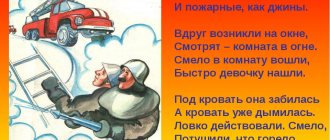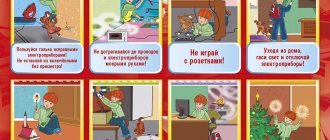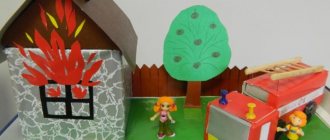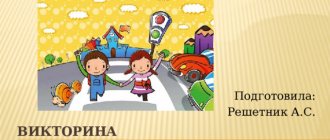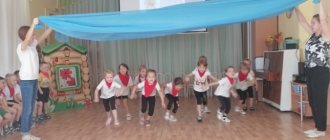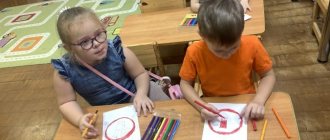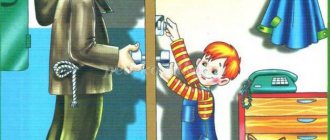It is no secret that fires most often occur due to the carelessness of people, and the most careless of us are children. This is why it is so important to introduce fire safety games for children from a very early age. Through play, kids learn to understand what objects can catch fire and what to do in a life-threatening situation.
At what age should fire safety rules be taught?
Dangers await people everywhere. At any moment an accident, fire, animal bite, etc. can happen. An adult has a certain model of behavior in this case, but a child does not. Therefore, it is so important to give him knowledge about possible threatening situations and objects. Children receive their first lessons in the family: “you can’t touch matches,” “it’s dangerous to approach the stove.” In the garden they deepen this knowledge.
It is recommended that children be introduced to fire safety rules from the age of 3 years. First, a series of introductory lessons are conducted to help you learn what is dangerous and what is not. Children learn to recognize fire hazards and handle them correctly. Later, starting from 4–5 years old, they learn to understand the interconnection of events: “a lit match can lead to a fire in the house, an unextinguished fire can burn a forest.”
How to behave in case of fire?
At a young age, a child is not able to put out a fire and follow the rules that exist for adults.
Up to 6 years of age, children must know and follow only 3 points:
- Do not touch flammable objects.
- In case of fire, notify parents, neighbors, and teacher as soon as possible.
- Remain in the sight of adults, obey them in everything and try to behave calmly.
At 7–8 years old, when the child begins to be left unattended, he is told about the first fire safety rules:
- If the fire is small, try to extinguish it by throwing a thick cloth, pouring a pan of water or covering it with sand.
- If this does not help or the fire is large, immediately leave the dangerous place.
- Don't hide under the bed or in the closet, but if possible, get out of the house.
- If you are locked inside, close the windows and doors in the room where the fire occurred. Take your phone and lock yourself in the bathroom. Plug all the cracks and the hood.
- Call the fire department on 101 as soon as possible or ask adults to do this: neighbors, passers-by.
- Smoke is more dangerous than fire. If you feel like you're starting to choke, lie down on the floor. There is always less smoke at the bottom.
- Do not use the elevator during a fire - it may shut down. Just go down the stairs.
- Stay calm and don't try to leave the house through the window.
- When the firefighters arrive, obey them in everything and do not be afraid. They will help you.
Card index of games according to fire safety rules
Card index of games according to fire safety rules
Didactic game: “Loto - fire safety”
Goal: using story pictures to form children’s understanding of dangerous situations during a fire; the ability to behave correctly in a dangerous situation. Develop attention, logical thinking, coherent speech. Foster a sense of responsibility.
Progress of the game:
The teacher gives the players cards drawn into 10 empty rectangles (playing fields), then shows the children a plot picture depicting the situation during a fire (a boy plays with matches, a girl ran out onto the balcony of a burning apartment, an iron was left unattended, children turned on the Christmas tree, etc. ). The child, who has correctly described the situation, covers the empty playing field with a picture. The one who has the most closed fields wins.
Didactic game "Card Quiz".
Goal: to consolidate children's knowledge about fire safety rules. Develop memory, thinking, speech. Foster a sense of responsibility.
Progress of the game:
The teacher lays out on the table, or puts in a beautifully decorated box, cards with questions on the topic of rules of behavior during a fire. The child who answers the question correctly gets a chip. The one who has the most chips at the end of the game wins.
Question options:
— Name the possible cause of the fire;
- how to call the fire department correctly;
- what to do if during a fire there is no way to call the fire brigade, and the routes out of the house are cut off by the fire;
— is it possible to extinguish a fire without first calling the fire brigade;
- what to do if there is a smell of gas in the house;
— is it possible to hide in a closet or under a table during a fire;
— Is it possible to set poplar fluff on fire?
— is it possible to create a draft during a fire by opening all windows and doors at the same time;
— is it possible to use the elevator during a fire in the house;
— what needs to be saved first during a fire: money, documents or yourself;
— how to properly leave a smoky room;
— Is it possible to play with matches and lighters and why.
Didactic game: “Name the causes of the fire”
Goal: to develop knowledge about the causes of fire. To develop attention, memory, speech. Cultivate responsibility.
Progress of the game:
From the plot pictures proposed by the teacher (children collecting autumn leaves, children hanging burning candles on the Christmas tree, a boy playing with matches in the closet, children watering flowers, etc.), the child must choose those situations that could cause a fire and justify his answer, for that gets the chip. The one who has the most chips at the end of the game wins.
Didactic game: “Choose the right one”
Goal: to develop children’s knowledge about the items needed when extinguishing a fire, the rules for their use. Reinforce knowledge about objects that can cause a fire. Develop speech, memory, logical thinking. Foster a sense of responsibility.
Progress of the game:
The child is offered a set of subject pictures (fire extinguisher, bucket of water. TV. Telephone, sandbox, electrical outlet, fire hose, kerosene lamp, fireman's helmet, lighter, gas stove, gas mask) from which he must select those used in extinguishing fires and those that are the cause. occurrence of a fire. The one who answers correctly gets a chip. The player who receives the most chips wins.
Didactic game: “Fold the picture”
Goal: to consolidate knowledge about the rules of behavior during a fire. Develop imagination, logical thinking, fine motor skills. Cultivate perseverance.
Progress of the game:
The child must put together a picture cut into 8-10 parts depicting a fire situation.
Card index of games according to fire safety rules
Didactic game: “Loto - fire safety”
Goal: using story pictures to form children’s understanding of dangerous situations during a fire; the ability to behave correctly in a dangerous situation. Develop attention, logical thinking, coherent speech. Foster a sense of responsibility.
Progress of the game:
The teacher gives the players cards drawn into 10 empty rectangles (playing fields), then shows the children a plot picture depicting the situation during a fire (a boy plays with matches, a girl ran out onto the balcony of a burning apartment, an iron was left unattended, children turned on the Christmas tree, etc. ). The child, who has correctly described the situation, covers the empty playing field with a picture. The one who has the most closed fields wins.
How to properly tell your child about fire safety rules?
You can tell your child as much as you like about safe behavior, but he is unlikely to remember and learn the instructions well. The main activity of children is play. It is easier to convey any information to children through play. In the game process, the child sees a clear example, acts out actions, and better understands cause-and-effect relationships.
There are several types of fire safety games for children:
- Didactic. They include games with objects and cards, board games and word games with riddles. For example, you need to cover a card with fire with a picture of water or continue the phrase: “I saw smoke - don’t yawn and call the firefighters... (call). “Don’t touch the stove with your hand if there’s a fire in it... (fire).”
- Movable. They help develop attentiveness, dexterity, and form a model of behavior in a life-threatening situation.
- Role-playing. Children take on the roles of firefighters, parents, children and solve the task.
It is recommended to support the oral material presented with a clear example. It is best to prepare a presentation with picture slides for the lesson. Instead of a dry presentation, you can use poetry:
“Mom-mouse ironed a suit for her daughter in the dark night. She got distracted and suddenly Forgot about the iron. This is no joke, it broke out in three minutes. Everything is in smoke, there is fumes all around, That’s how a fire happens!”
“Children were playing by the fire, Petya’s jacket caught fire, he rushed about in fright, But Nikita helped his friend: he knocked Petya onto his side and doused him with water... They had to throw earth on him so that the flames would subside. It is forbidden to run in burning clothes; the wind makes the fire flare up stronger!”
To consolidate the material, it is useful to make crafts and applications. In the kindergarten, teachers instruct parents to draw warning posters together with their children. You can make crafts from plasticine, colored cardboard and other materials. Example:
Examples of role-playing games
Role-playing games are carried out in the middle and senior groups of kindergarten. Recommended age: 4–5 and 6–7 years.
- “Everyone is leaving.” Players line up along the wall. At the opposite end of the room there are chairs with equipment: a helmet, gloves, a belt, a hose, a toy ladder and a fire extinguisher. When the whistle blows, the children run to the chairs and put on their equipment. Whoever does it faster wins.
- "Teamwork". Children are divided into 2 groups and lined up. A basin with water and a ladle is placed at the beginning of the line, and an empty basin is placed at the end. You need to scoop up the water and pass it to the player standing next to you. Children pass a ladle of water along a chain and pour it into an empty basin. The last player runs with an empty scoop to the beginning of the line, draws water and passes it to the team. The game continues until the first bowl is empty. The winner is the team that transfers all the water before the other. The amount of water transferred is also taken into account (whether it was spilled too much).
- “Is fire good or evil?” Each child is given a card. All cards have different pictures: cooking dinner over a fire, lighting a house, fireworks, a rocket flying. And also a fire in the forest, a burning house, a person coughing from the smoke, frightened children. In front of the children there is a stand with 2 drawn lights - good and evil. The child needs to approach the fire in accordance with his card and explain in his own words why the fire is good or evil. At the end of the game, the adult sums it up: “Fire is both good and evil. It all depends on how you handle it.”
- "Brave firefighters." Children are divided into boy-girl pairs. The girls sit on a chair and play the role of fire victims. The boys are rescue firefighters who must overcome an obstacle course and lead the girl by the hand to a safe place. The couple that runs back first wins.
- "Extinguishing the fire." The game involves 2 players. In front of each person, 6 red scraps (lights) and 10 pictures with objects that can be used to put out the fire are scattered on the floor. Among them are 4 incorrect ones: paper, firewood, doll, inflatable ball. When the whistle blows, you need to cover the “lights” with the correct pictures. Whoever completes the task first wins.
For role-playing games on the topic of fire safety, it will be useful to equip a corner with household items: an iron, stove, matches, as well as toys, an album and everything that is at home. Children act out a given scenario: “The parents left, and you were left alone at home. What will you play with? Or: “You are playing in the room and suddenly you smell smoke. What will you do?". You can distribute roles among children and divide them into parents, firefighters, children, neighbors, etc.
Children aged 3–6 years copy the actions of adults in their games. And all “adult” activities and subjects arouse strong interest. Do not tempt fate and keep matches, flammable liquids, candles, electric stoves and other fire hazards in a visible place. Do not use them in games and regularly have preventive conversations with your child. It is recommended to conduct a full-fledged fire safety lesson 1-2 times a year, starting from 3 years of age. In kindergarten, firefighters are invited, they show presentations and play games. Then life safety lessons are held at school. Children are given in-depth knowledge and taught how to properly handle fire-hazardous objects, and not avoid them.
Card index of outdoor games ON FIRE SAFETY, in the senior group
Municipal budgetary preschool educational institution
Kindergarten No. 8 “Topolek”
Card index of outdoor games
FIRE SAFETY GAMES
Game "Fire"
One player is selected from each team.
At a conventional signal (fire siren), players run from the starting line to the chairs on which the “firefighter’s ammunition” is laid out:
for example, helmet, gloves, belt, etc. “Firefighters” must prepare for departure - put on ammunition. The one who gets dressed the fastest wins.
The game can be complicated if several players from each team participate in it - for example, three.
Then each player who has already “dressed up” runs to the starting line and passes the baton to his friend.
The team whose players get dressed first and line up at the starting line wins.
You can make the relay race two-stage. Then each team is divided into two parts. Then each team is divided into two parts. Some players are “dressing up as firefighters”, others are “preparing a fire truck”.
After the members of the first group get dressed and line up on the starting line, they pass the baton to the players of the other group. The task of the latter is to assemble a cut-out picture - an image of a fire truck.
Game "Brave Firemen"
One player is selected from each team.
On command, players must go through an obstacle course, get to the chairs with the doll and take it out of the fire. The one who reaches the finish line first wins.
The game can be complicated by asking the “firemen” to move blindfolded.
Game "After the Fire"
Two players are selected from each team.
They sit on chairs and pick up a reel, to which a cord is attached at one end. On command, the players begin to wind the cord. The one who finishes first wins.
The game can be repeated several times - with the participation of other team members.
Game "Putting out the fire"
Rules of the game: children are divided into 2-3 teams, each team is given a “fire extinguisher”. Not far away are placed (according to the number of teams) objects that need to be extinguished (a large cube; a rubber inflatable toy, etc.). On command, the participants each run to their object, run around it (extinguish it), put a “fire extinguisher” nearby and run away to the side. As soon as the “fire extinguisher” touches the ground, the next participant in the game runs. Victory is awarded to the team that puts out the fire first.
Game "Bonfire"
Rules of the game: children are divided into 2-3 teams. You need to carry sand from the sandbox with a small children's scoop or spoon (without spilling it while running) and put out the fire (sprinkle it on a piece of paper with a picture of a fire). The winner is the team that brings more sand to the “bonfire” in the same amount of time, i.e. It’s better to “put out” the fire.
Sports game "Fire drills"
The presenter welcomes all participants, fans, guests and informs that the sports game is dedicated to people whose profession is a firefighter.
Leading. Fire brings warmth and joy to people, but sometimes it can become a dangerous and cruel enemy. In the path of fire, brave and smart, fast and resourceful people stand in the way - firefighters. They fight the fire and rescue the victims.
Then the presenter introduces the children's teams, names the judges and announces the start of the game.
Game “What you need in case of fire”
Progress of the game. The members of each team line up one after another in one line. At the command of the leader, they run to the table on which objects or images related to the profession of a firefighter (helmet, gas mask, fire extinguisher, etc.) and not related to this profession are laid out. The player must quickly select the desired item and return to the team. Then the next child performs the same actions, and so on. The team whose players complete the task faster wins.
Game "Who can get dressed faster"
Progress of the game. The teams line up behind the starting line, at a short distance from which two suitcases with the same set of items are placed: helmet, jacket, boots. At the leader’s signal, a player from each team runs up to his suitcase, opens it, gets dressed and runs to the starting line. There he takes off his clothes and passes them on to the next player, who, having dressed, runs to the suitcase, takes off and puts things down and returns to the team, etc.
Relay "Top Floor"
Children climb up an inclined bench onto a gymnastics wall, climb onto the adjacent flight, then jump onto the mat.
Relay race “Dismantling fire hoses”
The first child standing in the column of each team runs to the pyramid on which the rope is wound, unwinds it and returns back. The second one runs and wraps the rope around the pyramid. Etc.
Firefighting Relay Race
The child in front of each team has a bucket of “water” in his hands. He must run along the bench, climb through the “window” (hoop), cover the distance by stepping over objects, “pour out the water” and run back. The next player does the same.
Relay race “Smoky corridor”
Members of each team line up in front of their tunnel, take turns crawling along it, then run back.
Game “What you need in case of fire”
Progress of the game.
The members of each team line up one after another in one line.
At the command of the leader, they run to the table on which objects or images related to the profession of a firefighter (helmet, gas mask, fire extinguisher, etc.)
and not related to this profession are laid out. The player must quickly select the desired item and return to the team. Then the next child performs the same actions, and so on. The team whose players complete the task faster wins.
